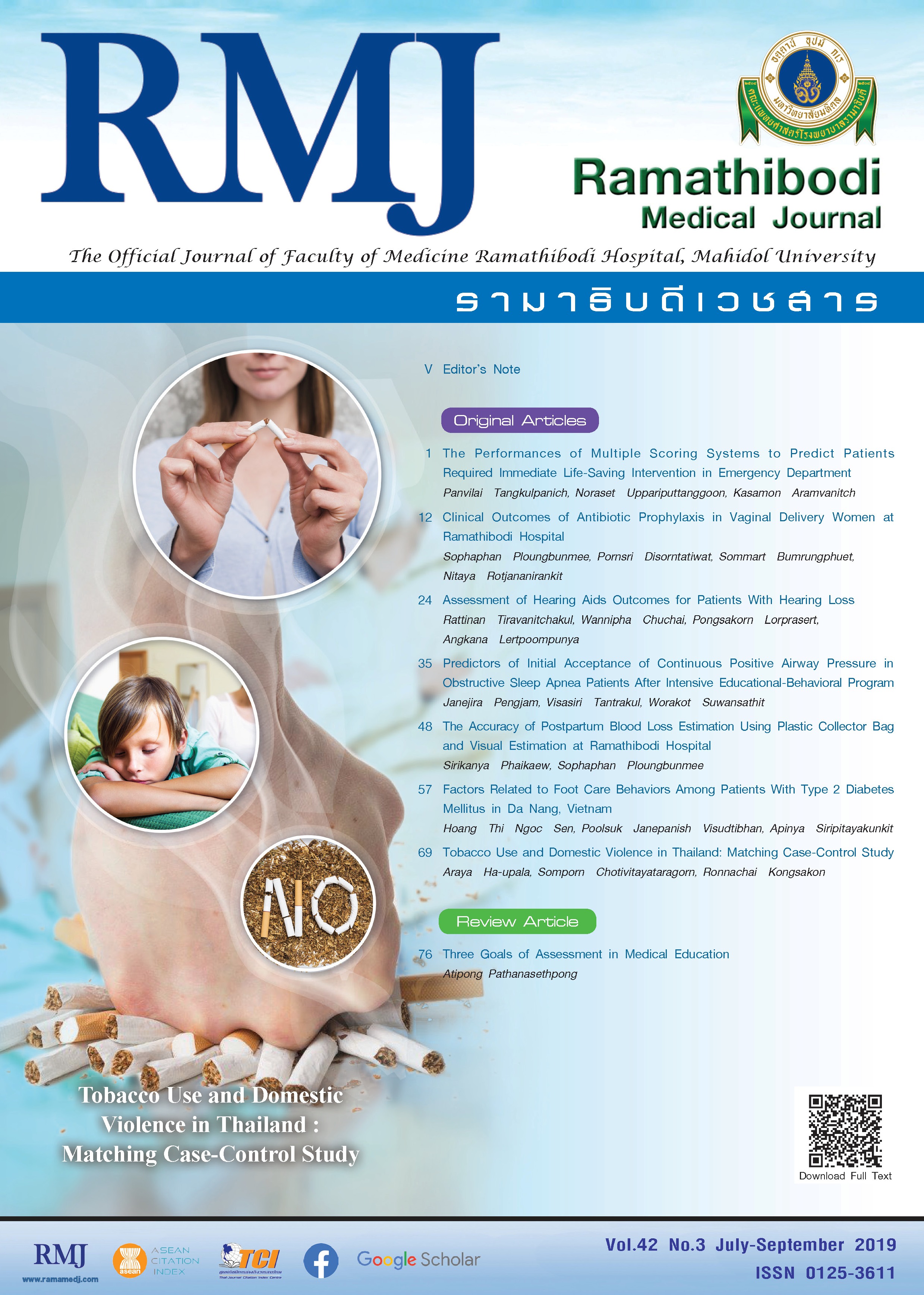The Performances of Multiple Scoring Systems to Predict Patients Required Immediate Life-Saving Intervention in Emergency Department
DOI:
https://doi.org/10.33165/rmj.2019.42.3.138690Keywords:
Scoring system, Life-saving interventions, NEWS, WPS, MEWS, REMSAbstract
Background: Crowding in emergency room is the major problem especially in the resuscitation room. Many patients require immediate life-saving interventions (LSI). Whereas, many different scoring systems such as national early warning score (NEWS), worthing physiological scoring system (WPS), modified early warning score (MEWS), and rapid emergency medicine score (REMS) have been developed for assessing patients at risk.
Objective: To evaluate the effectiveness of 4 scoring systems performance in predicting LSI use in emergency room and reenter to the resuscitation room within 48 hours.
Methods: Data were collected by a retrospective cross-sectional study of patients treated in the resuscitation room for 2 months period, at Ramathibodi Hospital. The number of patients who received LSI and reentry to resuscitation room were studied, compared by selected scoring systems.
Results: Total 839 patients entered resuscitation room, while 331 (39.45%) patients received LSI. The first three groups at risk were metabolic diseases, gastrointestinal systems, and infections, respectively. The most effective scoring system in predicting patients required LSI was MEWS, the discrimination of this system was significantly better than NEWS (AUC, 0.69 vs 0.65; 95% CI, 0.65 - 0.72; P = .01). Eighty-six patients (13.89%) from 619 patients reentered to the resuscitation room. Moreover, NEWS was the most effective in predicting patients who had a risk of reenter (AUC, 0.72; 95% CI, 0.66 - 0.78; P < .001).
Conclusions: MEWS is the most effective scoring system for patient assessment of LSI utilization. However, NEWS is the one suitable for predicting reenter tendency.
References
Gilboy N, Tanabe P, Travers DA, Rosenau AM, Eitel DR. Emergency Severity Index, Version 4: Implementation Handbook. Rockville, MD: Agency for Healthcare Research and Quality; 2005. https://www.sgnor.ch/uploads/tx_frptaggeddownloads/esihandbk.pdf. Accessed January 23, 2019.
Smith ME, Chiovaro JC, O'Neil M, et al. Early warning system scores for clinical deterioration in hospitalized patients: a systematic review. Ann Am Thorac Soc. 2014;11(9):1454-1465. doi:10.1513/AnnalsATS.201403-102OC.
Morgan RJM WF, Wright MM. An early warning scoring system for detecting developing critical illness. Clin Intensive Care. 1997;8:100.
Carberry M. Implementing the modified early warning system: our experiences. Nurs Crit Care. 2002;7(5):220-226.
Subbe CP, Kruger M, Rutherford P, Gemmel L. Validation of a modified early warning score in medical admissions. QJM. 2001;94(10):521-526.
Ha DT, Dang TQ, Tran NV, Vo NY, Nguyen ND, Nguyen TV. Prognostic performance of the rapid emergency medicine score (REMS) and worthing physiological scoring system (WPS) in emergency department. Int J Emerg Med. 2015;8:18. doi:10.1186/s12245-015-0066-3.
Olsson T, Lind L. Comparison of the rapid emergency medicine score and APACHE II in nonsurgical emergency department patients. Acad Emerg Med. 2003;10(10):1040-1048. doi:10.1197/S1069-6563(03)00342-7.
Duckitt RW, Buxton-Thomas R, Walker J, et al. Worthing physiological scoring system: derivation and validation of a physiological early-warning system for medical admissions. an observational, population-based single-centre study. Br J Anaesth. 2007;98(6):769-774. doi:10.1093/bja/aem097.
National Clinical Effectiveness Committee. National Early Warning Score: National Clinical Guideline No. 1. Dublin, Ireland: Health Service Executive (HSE); 2013;5-24. https://health.gov.ie/wp-content/uploads/2015/01/NEWSFull-ReportAugust2014.pdf. Accessed January 23, 2019.
Royal College of Physicians. National Early Warning Score (NEWS): Standardising the assessment of acute illness severity in the NHS. London: Report of a working party Royal College of Physicians; 2012:8-24.
Vishnu A, Gurka MJ, DeBoer MD. The severity of the metabolic syndrome increases over time within individuals, independent of baseline metabolic syndrome status and medication use: the atherosclerosis risk in communities study. Atherosclerosis. 2015;243(1):278-285. doi:10.1016/j.atherosclerosis.2015.09.025.
Yamada T, Alpers DH, Kalloo AN, Kaplowitz N, Owyang C, Powell DW. Textbook of Gastroenterology. 5th ed. West Sussex, UK: Wiley-Blackwell; 2009:133-168. https://leseprobe.buch.de/images-adb/58/c3/58c326b5-9215-4f9c-a6ac-6e441b08ca92.pdf. Accessed January 23, 2019.
Angkasekwinai N, Rattanaumpawan P, Thamlikitkul V. Epidemiology of sepsis in Siriraj Hospital 2007. J Med Assoc Thai. 2009;92(Suppl 2):S68-S78.
Khwannimit B, Bhurayanontachai R. The epidemiology of, and risk factors for, mortality from severe sepsis and septic shock in a tertiary-care university hospital setting. Epidemiol Infect. 2009;137(9):1333-1341. doi:10.1017/S0950
Cooper S, Barrett B, Black S, et al. The emerging role of the emergency care practitioner. Emerg Med J. 2004;21(5):614-618. doi:10.1136/emj.2003.011247.

















